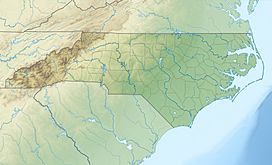Cowee Gap facts for kids
Quick facts for kids Cowee Gap |
|
|---|---|
| Elevation | 4,199 ft (1,280 m) |
| Traversed by | |
| Location | |
| Range | Cowee Mountains |
| Coordinates | 35°05′27″N 83°08′52″W / 35.0909258°N 83.1476479°W |
| Topo map | USGS Highlands |
Cowee Gap is a mountain pass in western North Carolina. It sits high up at about 4,199 feet (1,280 meters) above sea level. This gap is found between the towns of Highlands and Cashiers. It's a special spot because it's on the Eastern Continental Divide. This means that water on one side flows to the Atlantic Ocean, and water on the other side flows to the Gulf of Mexico.
What is Cowee Gap?
Cowee Gap is a natural low point between mountains. It makes it easier for people and roads to cross over high terrain. This gap is part of the Cowee Mountains. It also marks the border between Macon County and Jackson County.
Where Does the Water Go?
The Eastern Continental Divide runs right through Cowee Gap. This divide separates two major river systems. Water flowing west from the gap goes into the Cullasaja River. This river eventually joins the Tennessee River. The Tennessee River then flows into the Mississippi River and finally to the Gulf of Mexico. Water flowing east from the gap goes into the Chattooga River. This river is part of the larger Savannah River basin, which flows into the Atlantic Ocean.
Traveling Through the Gap
U.S. Route 64 crosses through Cowee Gap. The road here has a very sharp turn called a switchback. As you drive near the gap, especially just north of it, you can see Whiteside Mountain. It's a tall, impressive mountain to the southeast.
The name of the road changes at Cowee Gap. When you are driving towards Highlands, it is called Cashiers Road. When you are driving towards Cashiers, it is called Highlands Road. This name change happens right at the county line within the gap.
A Bit of History
Cowee Gap has a history that dates back many years. In the past, a conflict known as the Battle of Cowee Gap happened nearby. This battle was between early settlers and the Cherokee people. It was an important event in the history of the region.


